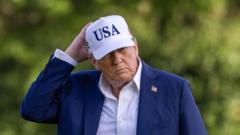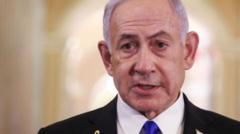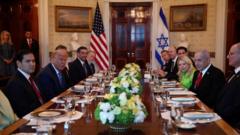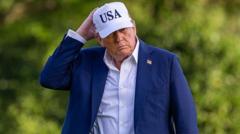As the clock ticks towards a new deadline, the expected outcomes of Trump's tariff strategy appear increasingly uncertain.
Trump's Tariff Strategy Faces Delays Amid Tough Global Negotiations

Trump's Tariff Strategy Faces Delays Amid Tough Global Negotiations
President Trump's promised trade deals remain elusive as tariff deadlines are extended, highlighting growing tensions with international partners.
In the wake of President Donald Trump's aggressive tariff agenda, the administration has found itself navigating a labyrinth of delays and diplomatic challenges, prompting an extension to the proposed deadline for reaching trade agreements until August 1. Initial hopes for "90 deals in 90 days" have faded, with experts predicting that fewer than 10 deals may realistically be completed by the revised date.
The decision to prolong the tariff negotiations signals a broader acknowledgment of the struggles faced by the Trump administration in securing significant international agreements. With Treasury Secretary Scott Bessent redirecting focus on the 18 countries responsible for 95% of the U.S. trade deficit, frustration has mounted among U.S. trading partners like Japan and South Korea, who are reacting angrily to the perceived heavy-handedness of U.S. tactics.
Though the market response to this latest extension has been relatively muted, it reflects a growing skepticism about the efficacy of the Trump administration's approach to international trade. Financial analysts have noted a phenomenon dubbed TACO (Trump Always Chickens Out), suggesting that anticipated delays could hinder negotiations further and spark renewed economic crisis.
This situation is compounded by the troubling trend of declining trade numbers. U.S. exports to China have plummeted by 9.7% thus far in 2023, while China's shipments to the global market have surged—a clear indication that trade dynamics are shifting rapidly.
Importantly, the effective tariff rate imposed by the U.S. has risen significantly from historical averages—from around 2% to 4% over the past 40 years to an alarming 15% today—highlighting the deeper ramifications of tariff-related strategies on global trade patterns. Despite record treasury receipts attributed to tariff revenues in recent months, analysts warn that the broader economic implications remain uncertain, and the potential for increased market volatility looms large.
As geopolitical tensions rise, stakeholders worldwide are seeking alternatives, evidenced by growing trade relationships among nations outside the U.S. As the landscape of global trade continues to evolve, the coming weeks will be crucial in determining how President Trump's administration navigates these complex challenges and whether a coherent strategy may emerge from the current impasse.
The decision to prolong the tariff negotiations signals a broader acknowledgment of the struggles faced by the Trump administration in securing significant international agreements. With Treasury Secretary Scott Bessent redirecting focus on the 18 countries responsible for 95% of the U.S. trade deficit, frustration has mounted among U.S. trading partners like Japan and South Korea, who are reacting angrily to the perceived heavy-handedness of U.S. tactics.
Though the market response to this latest extension has been relatively muted, it reflects a growing skepticism about the efficacy of the Trump administration's approach to international trade. Financial analysts have noted a phenomenon dubbed TACO (Trump Always Chickens Out), suggesting that anticipated delays could hinder negotiations further and spark renewed economic crisis.
This situation is compounded by the troubling trend of declining trade numbers. U.S. exports to China have plummeted by 9.7% thus far in 2023, while China's shipments to the global market have surged—a clear indication that trade dynamics are shifting rapidly.
Importantly, the effective tariff rate imposed by the U.S. has risen significantly from historical averages—from around 2% to 4% over the past 40 years to an alarming 15% today—highlighting the deeper ramifications of tariff-related strategies on global trade patterns. Despite record treasury receipts attributed to tariff revenues in recent months, analysts warn that the broader economic implications remain uncertain, and the potential for increased market volatility looms large.
As geopolitical tensions rise, stakeholders worldwide are seeking alternatives, evidenced by growing trade relationships among nations outside the U.S. As the landscape of global trade continues to evolve, the coming weeks will be crucial in determining how President Trump's administration navigates these complex challenges and whether a coherent strategy may emerge from the current impasse.




















